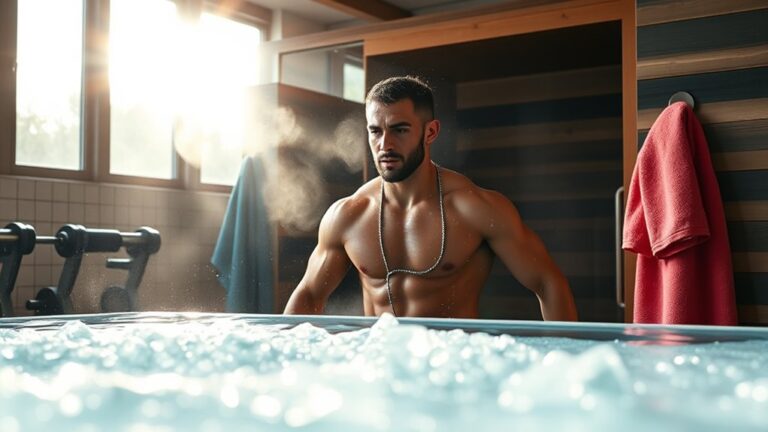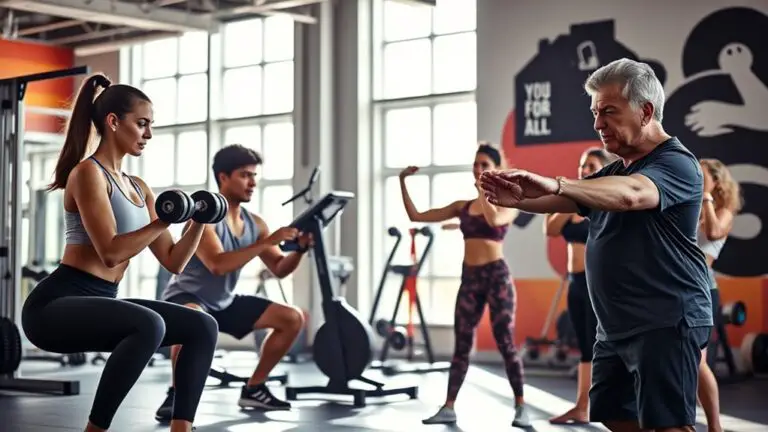How to Use Cryotherapy for Faster Gym Recovery
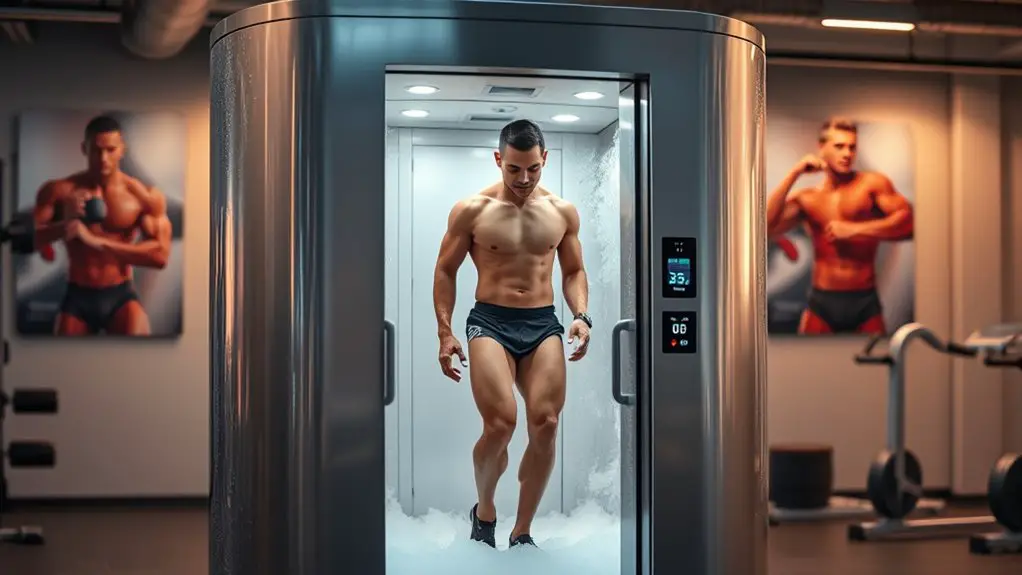
To use cryotherapy for faster gym recovery, try whole body or local cryotherapy sessions after intense workouts. These treatments reduce inflammation and muscle soreness by exposing your body to cold, helping speed up healing. Wear comfortable clothing, hydrate beforehand, and avoid heavy meals before your session. You might want to combine this with other recovery methods like massage therapy or nutrition strategies for even better results. Keep exploring the potential benefits and personalize your approach for ideal recovery.
What Is Cryotherapy?

Cryotherapy, often referred to as cold therapy, is a recovery technique that involves exposing the body to extremely low temperatures for a short period. Its history dates back to ancient civilizations, where ice and cold water were used for healing. Over the years, the method evolved into what is currently understood, with modern cryotherapy chambers enhancing the experience. However, several cryotherapy misconceptions persist. Many people think it’s only for elite athletes, but it’s accessible to anyone looking to boost recovery or reduce inflammation. Others worry about safety, yet when done properly, it’s generally safe and well-tolerated. By understanding cryotherapy’s history and dispelling these myths, you can appreciate its potential benefits for gym recovery. So, if you’re curious about how cold therapy might help you, consider giving it a try and experience the rejuvenating effects for yourself.
How Cryotherapy Works
Cryotherapy uses extreme cold to promote recovery, and understanding how it works can help you maximize its benefits. When you expose your body to low temperatures, it triggers a series of physiological responses that can reduce inflammation and enhance muscle repair. By harnessing these effects, you can speed up your recovery process after intense workouts.
Cold Exposure Benefits
When you’re pushing your body to the limits in the gym, cold exposure can be a game-changer for recovery. It helps reduce inflammation and muscle soreness, allowing you to bounce back faster after intense workouts. By exposing your body to cold, you constrict blood vessels and decrease metabolic activity, which can help manage pain and swelling. This process also promotes muscle recovery by flushing out metabolic waste and delivering essential nutrients to your muscles more efficiently. Plus, cold exposure can enhance your overall mood and energy levels, making you more motivated for your next session. If you’re looking to optimize your recovery routine, integrating cold exposure might be just what you need to keep those gains coming.
Mechanism of Action
Cold exposure, like that experienced during cryotherapy, operates on a fascinating physiological principle. When you subject your body to extreme cold, it triggers a series of responses aimed at preserving core temperature and protecting your muscles. This mechanism overview involves vasoconstriction, reducing blood flow to minimize inflammation. As your body warms up post-treatment, vasodilation occurs, increasing blood flow and facilitating nutrient delivery for recovery.
| Physiological Effect | Description |
|---|---|
| Reduced Inflammation | Decreases swelling and pain |
| Enhanced Circulation | Boosts nutrient flow to muscles |
| Pain Relief | Alters nerve signals to lessen discomfort |
Benefits of Cryotherapy for Gym Recovery
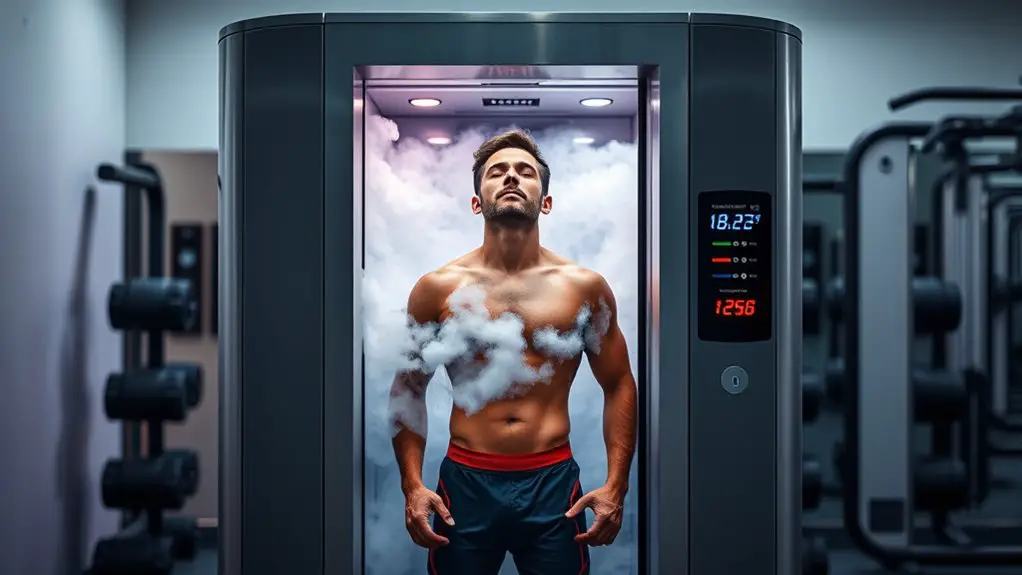
As you push your limits in the gym, the recovery process can often feel just as important as the workout itself. That’s where cryotherapy comes in, offering several cryotherapy benefits that can enhance your gym recovery. By exposing your body to extreme cold for a short period, you can greatly reduce muscle soreness and inflammation. This not only helps alleviate pain but also speeds up the healing of micro-tears in your muscles, allowing you to return to your workouts quicker.
Additionally, cryotherapy can improve circulation and boost your metabolism, giving you an extra edge in your fitness journey. You’ll also likely experience enhanced mood and reduced fatigue, making it easier to stay motivated. Overall, incorporating cryotherapy into your recovery routine can lead to faster results and improved performance, ensuring you’re always ready to tackle your next gym session. Embrace these benefits to maximize your fitness potential!
Different Types of Cryotherapy Treatments
There are several types of cryotherapy treatments available, each designed to cater to different recovery needs and preferences. Whole body cryotherapy involves stepping into a chamber where your body is exposed to extremely cold temperatures for a few minutes. This method helps reduce inflammation and speeds up recovery for athletes after intense workouts.
On the other hand, local cryotherapy focuses on specific areas of the body, like sore muscles or joints. Using localized cooling devices, this treatment targets discomfort and aids in muscle recovery more precisely.
You might choose whole body cryotherapy for overall recovery or local cryotherapy for targeted relief. Both options can enhance your gym performance and help you bounce back faster. Remember to consult with a professional to determine which treatment suits you best and fits into your recovery routine.
When to Use Cryotherapy in Your Routine
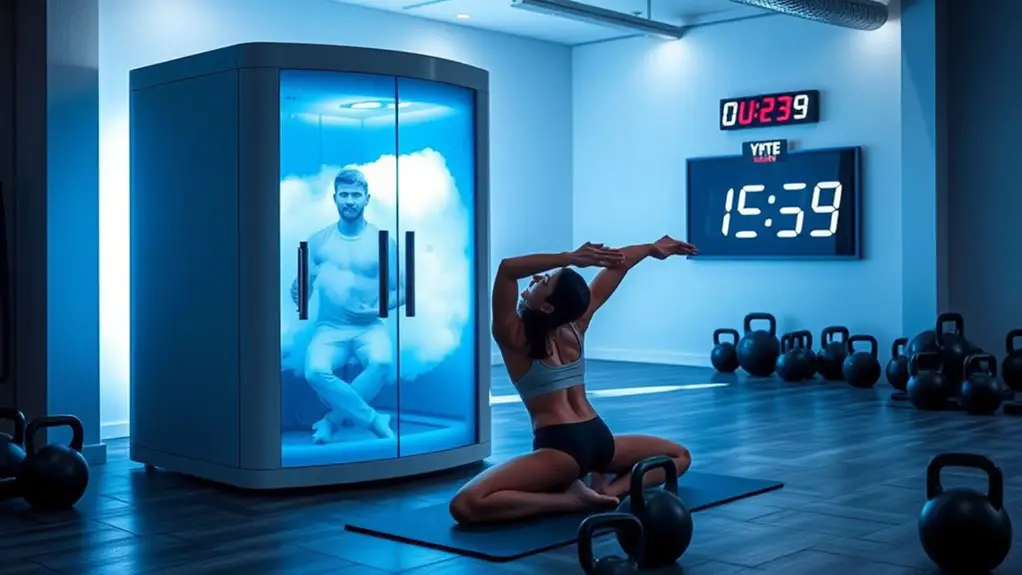
Knowing when to incorporate cryotherapy into your routine can greatly impact your recovery process. Proper timing strategies are essential for maximizing the benefits of cryotherapy. Here’s a simple table to help you decide when to use it:
| Timing | Ideal Situation | Benefit |
|---|---|---|
| Post-Workout | After intense training | Reduces inflammation |
| On Recovery Days | Between workout sessions | Enhances muscle repair |
| Before Competition | Prior to events | Prepares your body for peak performance |
Preparing for Your Cryotherapy Session
Preparing for your cryotherapy session can make a significant difference in your overall experience and results. To guarantee you’re ready, consider these essential tips:
- Choose the right session attire: Wear loose-fitting, comfortable clothing and avoid any metallic accessories.
- Pre-session hydration: Drink plenty of water before your session to enhance your body’s recovery process.
- Avoid heavy meals: Don’t eat a large meal right before your session; a light snack is sufficient.
- Limit intense workouts: Try not to engage in strenuous exercise immediately before your appointment, as it can affect your tolerance to the cold.
- Arrive early: Give yourself time to relax and acclimate to the environment before your session begins.
What to Expect During a Cryotherapy Session
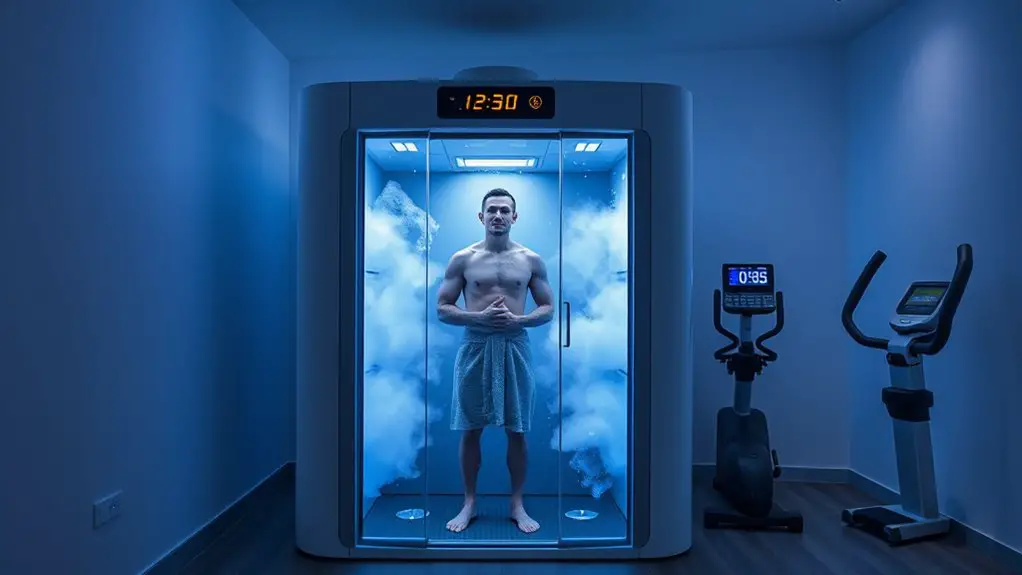
During a cryotherapy session, you can expect the process to last about three minutes, with the temperature dropping considerably to stimulate recovery. As you experience the cold, you might feel a range of sensations, from tingling to a rush of energy. It’s important to follow safety tips provided by your technician to guarantee a comfortable and effective experience.
Session Duration and Process
When you step into a cryotherapy chamber for the first time, you might wonder what to expect in relation to session duration and the overall process. Typically, a session lasts around 2-3 minutes, but it can feel even shorter once you get started. Here’s what you should keep in mind:
- Wear proper attire: Lightweight, moisture-wicking clothing is ideal.
- Remove jewelry: Metal can conduct cold and cause discomfort.
- Prepare for the cold: The chamber will be set to -100°F to -200°F.
- Stay still: Movement can increase your exposure to extreme temperatures.
- Follow instructions: Your technician will guide you throughout the session.
Sensations and Safety Tips
As you settle into the cryotherapy chamber, you might experience a mix of sensations as the cold envelops you. Initially, it can feel shocking, but you’ll quickly adapt to the chill. Some common sensations experienced include tingling, slight numbness, and a rush of energy as blood flow increases. Remember, you’re only in there for a few minutes, so focus on your breathing to stay relaxed.
For safety precautions, make sure to wear protective gloves and socks to prevent frostbite, and avoid staying in the chamber longer than recommended. If you have any medical conditions, consult with a professional beforehand. By understanding what to expect, you can maximize the benefits and enjoy your cryotherapy session safely.
Combining Cryotherapy With Other Recovery Methods
While cryotherapy offers impressive benefits for gym recovery, combining it with other recovery methods can enhance your overall performance and well-being. To maximize your results, consider integrating the following techniques into your routine:
Combining cryotherapy with other recovery methods can significantly enhance your performance and well-being.
- Hot therapy: Alternating between hot and cold can improve circulation and reduce muscle soreness.
- Massage therapy: Regular massages help relieve tension and promote relaxation, complementing cryotherapy’s effects.
- Active recovery: Engaging in low-intensity activities can keep blood flowing, aiding muscle repair.
- Nutrition strategies: Fueling your body with the right nutrients post-workout supports recovery and muscle growth.
- Hydration importance: Staying hydrated is essential for peak performance and recovery, so don’t forget to drink water.
Incorporating these methods alongside cryotherapy can create a thorough recovery plan, helping you feel refreshed, energized, and ready for your next workout.
Potential Risks and Considerations
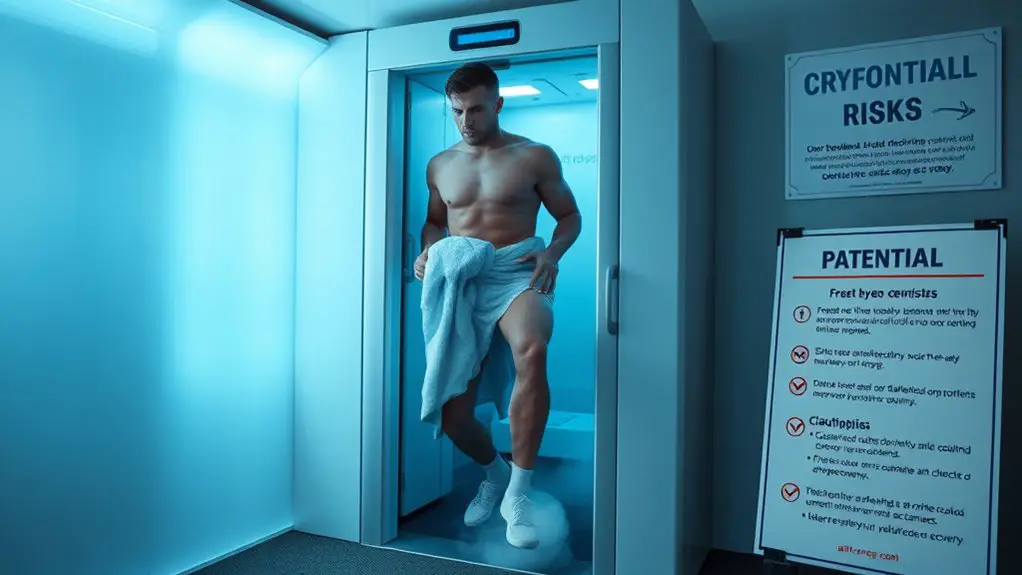
Integrating various recovery methods alongside cryotherapy is beneficial, but it’s also important to be aware of potential risks and considerations. Not everyone responds the same way to cryotherapy due to different physical conditions and individual reactions. Before diving in, it’s essential to consult with healthcare professionals, especially if you have pre-existing health issues or are pregnant.
Here’s a quick overview of potential risks:
| Risk Factor | Description | Consideration |
|---|---|---|
| Frostbite | Skin exposure to extreme cold | Limit exposure time |
| Nerve Damage | Prolonged cold exposure can harm nerves | Monitor sensations |
| Blood Pressure Changes | Sudden temperature changes can affect BP | Consult a doctor if concerned |
| Claustrophobia | Enclosed spaces may trigger anxiety | Choose open cryo options |
| Allergic Reactions | Some may react to cold or materials | Test a small area first |
Stay informed and prioritize safety for effective recovery!
Personalizing Your Cryotherapy Experience
To truly benefit from cryotherapy, you should tailor the experience to meet your individual needs and preferences. This personalization can enhance recovery and overall performance. Here are some tips for creating customized sessions that align with your individual goals:
- Duration: Adjust the length of your sessions based on your fitness level and recovery needs.
- Temperature: Experiment with different temperatures to find what feels best for your body.
- Frequency: Determine how often you should undergo cryotherapy for ideal results, whether it’s weekly or after intense workouts.
- Target Areas: Focus on specific muscle groups or joints that require extra attention.
- Hydration: Stay hydrated before and after sessions to maximize the benefits of cryotherapy.
Frequently Asked Questions
How Often Should I Schedule Cryotherapy Sessions for Optimal Recovery?
When considering session frequency for cryotherapy, you’ll want to aim for two to three sessions per week for ideal recovery benefits. This frequency allows your body to experience the effects regularly, helping to reduce inflammation and muscle soreness effectively. If you’re training intensely, you might even increase to four sessions. Just listen to your body and adjust as needed, ensuring you’re giving your muscles the best chance to recover and perform at their peak.
Can Cryotherapy Help With Chronic Pain or Injuries?
Did you know that around 50 million Americans suffer from chronic pain? Cryotherapy can be a game-changer for you if you’re dealing with chronic pain or recovering from an injury. By exposing your body to extreme cold, it reduces inflammation and boosts blood circulation, which may help alleviate pain and speed up recovery. Many people report significant relief after just a few sessions, making it a promising option for managing your discomfort.
Is Cryotherapy Safe for Everyone, Including Those With Medical Conditions?
Cryotherapy isn’t necessarily safe for everyone, especially if you’ve got certain medical conditions. While many people enjoy its benefits, like reduced inflammation and pain relief, it’s essential to consult a healthcare professional first. If you have cardiovascular issues, respiratory problems, or skin sensitivities, cryotherapy might not be the best option for you. Always prioritize your health and safety by discussing any concerns with your doctor before trying cryotherapy.
What Should I Wear During a Cryotherapy Session?
When you step into the icy chamber, imagine the chill wrapping around you like a crisp winter breeze. For your cryotherapy session, it’s best to wear minimal cryotherapy attire—think shorts and a sports bra or tank top. This helps your body adapt to the temperature sensitivity, allowing for maximum benefits. Don’t forget warm socks and gloves to protect your extremities. Stay cozy while experiencing the invigorating cold that rejuvenates your muscles!
How Soon After a Workout Can I Use Cryotherapy?
You can use cryotherapy as soon as 30 minutes after your workout. This post workout timing allows your body to start the recovery process while still benefiting from the cold therapy. Cryotherapy can help reduce inflammation, alleviate soreness, and improve muscle recovery, making it a fantastic addition to your routine. Just remember to listen to your body; if you feel too fatigued, it might be better to wait a bit longer.

